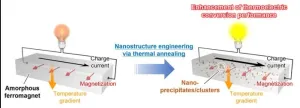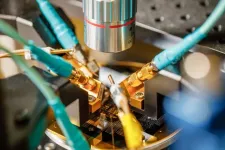(Press-News.org) Researchers at the University of California San Diego School of Medicine have shed new light on the changes in metabolism that occur between birth and the presentation of autism spectrum disorder (ASD) later in childhood. The researchers discovered that a small number of biochemical pathways are responsible for the majority of these changes, which could help inform new early detection and prevention strategies for autism.
“At birth, the physical appearance and behavior of a child who will develop autism over the next few years are indistinguishable from that of a neurotypical child. Indeed, in most cases the fate of the child with regard to autism is not set at birth,” said Robert Naviaux, M.D., Ph.D., professor in the Departments of Medicine, Pediatrics and Pathology at UC San Diego School of Medicine. “We’re starting to learn about the governing dynamics that regulate the transition from risk to the actual appearance of the first symptoms of ASD. Early diagnosis opens the possibility of early intervention and optimal outcomes.”
ASD is a developmental disorder characterized by difficulties in socializing and communication, as well as repetitive and/or restrictive behaviors. For the majority of people with ASD, the condition is a significant disability, with only 10-20 percent of children diagnosed before 5 years of age able to live independently as adults.
While autism is known to have strong genetic risk factors, there are also environmental risk factors that play a role in the development and severity of ASD. Naviaux and other researchers are discovering that the development of autism is governed by the real-time interaction of these varied factors. By studying the developmental biology of metabolism and how it differs in autism, new insights are emerging in ASD and other complex developmental disorders.
“Behavior and metabolism are linked – you cannot separate them,” added Naviaux.
To learn more about the early metabolic changes that occur in children with autism, researchers studied two cohorts of children. One cohort consisted of newborn children, in whom autism can’t be detected. The second cohort consisted of 5-year-old children, some of whom had been diagnosed with autism.
When comparing the metabolic profiles of children in the cohort who were eventually diagnosed with autism to those who developed neurotypically, they found striking differences. Of the 50 different biochemical pathways the researchers investigated, just 14 were responsible for 80 percent of the metabolic impact of autism.
The pathways that were most changed are related to the cell danger response, a natural and universal cellular reaction to injury or metabolic stress. The body has biochemical safeguards in place that can shut down the cell danger response once the threat has passed, and Naviaux hypothesizes that autism occurs when these safeguards fail to develop normally. The result is heightened sensitivity to environmental stimuli, and this effect contributes to sensory sensitivities and other symptoms associated with autism.
“Metabolism is the language that the brain, gut and immune system use to communicate, and autism occurs when the communication between these systems is changed,” added Naviaux.
The cell danger response is primarily regulated by adenosine triphosphate (ATP) the body’s chemical energy currency. While these ATP-signaling pathways do not develop normally in autism, they may be partially restorable with existing pharmaceutical drugs. In 2017, Naviaux and his team completed early clinical testing for suramin, the only drug approved in humans that can target ATP signaling and which is normally used to treat African sleeping sickness.
Now, the researchers hope that by revealing the specific ATP-related pathways that are altered in autism, their work will help scientists develop more drugs that target these pathways to manage the symptoms of ASD.
“Suramin is just one drug that targets the cell danger response,” he said. “Now that we’re closely interrogating how metabolism changes in ASD, we could be at the beginning of a drug renaissance that will create new options for treatment that never existed before.”
Link to full study: https://www.nature.com/articles/s42003-024-06102-y
Co-authors on the study include: Sai Sachin Lingampelly, Jane C. Naviaux, Jonathan M. Monk, Kefeng Li and Lin Wang at UC San Diego School of Medicine and Luke S. Heuer, Lori Haapanen, Chelsea A. Kelland and Judy Van de Water at University of California Davis This work was funded, in part, by Autism Speaks (grant 7274), the National Center for Research Resources (grant UL1TR001442), and through various philanthropic gifts.
# # #
END
Metabolism of autism reveals developmental origins
Findings suggest new possibilities for early autism detection
2024-05-10
ELSE PRESS RELEASES FROM THIS DATE:
Comparative analysis of robot-assisted language learning systems and human tutors in English conversation lessons
2024-05-10
Advancements in large language models, robotics, and software such as text-to-speech, have made it possible to develop robots that can understand language, interact physically, and communicate verbally. These breakthroughs have opened up possibilities for robots to be used for educational purposes. However, this raises the question of whether robots are as good as human tutors. While robots offer certain benefits, they cannot replicate the nuanced interactions and personalized feedback human tutors provide.
To determine the suitability of using ...
Under 4-minute milers’ longevity shows that extreme exercise doesn’t seem to curb lifespan
2024-05-10
Extreme exercise doesn’t seem to shorten the lifespan as is widely believed, suggest the findings of a study on the longevity of the first 200 athletes to run a mile in under 4 minutes, and published online in the British Journal of Sports Medicine.
They outlive the general population by several years, shows the study, which marks the 70th anniversary of the seminal achievement of Roger Bannister, who was the first person to run a mile in under 4 minutes in May 1954.
While regular moderate exercise is considered a pillar of healthy ageing, ...
Journal retracts 6 further articles and corrects 2 others authored by former editor
2024-05-10
The British Journal of Sports Medicine has retracted six further articles authored by former editor, Dr Paul McCrory, and corrected another two, following an extensive investigation of his sole authored content in the journal.*
The retractions comprise four ‘warm up’ editorials and one book review due to plagiarism. A letter has also been retracted because of duplicate publication. And a research article and a review article have been corrected due to inappropriate reuse of content.
This latest tranche of retractions and corrections completes BMJ’s 2-year investigation ...
Running under a four-minute mile could be the key to a long and healthy life
2024-05-10
A new study released to mark the 70th anniversary of Sir Roger Bannister’s sub-four-minute mile record has revealed the first 200 runners to follow in his footsteps also share another remarkable trait.
The study from investigators in Australia and Canada found the 200 elite runners live on average almost five years longer than the general population.
Professor Mark Haykowsky, the Research Chair in Aging and Quality of Life in the Faculty of Nursing at the University of Alberta, says the findings published in the British Journal of Sports Medicine demonstrate the vital importance of aerobic fitness.
Professor Haykowsky says: “Breaking ...
Transforming common soft magnets into a next-generation thermoelectric conversion materials by 3 minutes heat treatment
2024-05-10
1. A research team from NIMS and Nagoya University has demonstrated that an iron-based amorphous alloy, widely used as a soft magnetic material in transformers and motors, can be transformed into a "transverse" thermoelectric conversion material that converts electric and thermal currents in orthogonal directions, with just a short period of heat treatment. This is the first example that highlights the importance of microstructure engineering in the development of transverse thermoelectric conversion materials, and provides new design guidelines for materials development to realize environmentally friendly power generation and thermal management technologies ...
Good vibrations: New tech may lead to smaller, more powerful wireless devices
2024-05-09
What if your earbuds could do everything your smartphone can do already, except better? What sounds a bit like science fiction may actually not be so far off. A new class of synthetic materials could herald the next revolution of wireless technologies, enabling devices to be smaller, require less signal strength and use less power.
The key to these advances lies in what experts call phononics, which is similar to photonics. Both take advantage of similar physical laws and offer new ways to advance technology. While photonics takes advantage of photons – or light – phononics does the same with phonons, which are the physical particles that transmit mechanical vibrations ...
Revolutionizing nurse work environment research
2024-05-09
PHILADELPHIA (May 9, 2024) – New research from Penn Nursing’s Center for Health Outcomes and Policy Research (CHOPR) – recently published online in the journal Research in Nursing & Health – has successfully validated a new, streamlined version of the Practice Environment Scale of the Nursing Work Index (PES-NWI), originally authored in 2002 by Eileen T. Lake, PhD, RN, FAAN, Professor of Nursing, the Edith Clemmer Steinbright Professor in Gerontology, and Associate Director of CHOPR, who is also lead author on this publication. This innovative tool, known as the PES-5, is designed to revolutionize how nurse work environments are measured across ...
New ‘forever chemical’ cleanup strategy discovered
2024-05-09
As the U.S. Environmental Protection Agency cracks down on insidious “forever chemical” pollution in the environment, military and commercial aviation officials are seeking ways to clean up such pollution from decades of use of fire suppressant foams at military air bases and commercial airports.
Fire-suppression foams contain hundreds unhealthful forever chemicals, known by chemists as PFAS or poly- and per-fluoroalkyl substances. These compounds have stubbornly strong fluorine-to-carbon bonds, which allow them to persist indefinitely in the environment, hence the moniker “forever chemicals.” ...
Squeezed by neighbors, planet glows with molten lava
2024-05-09
UC Riverside astrophysicist Stephen Kane had to double check his calculations. He wasn’t sure the planet he was studying could be as extreme as it seemed.
Kane never expected to learn that a planet in this faraway star system is covered with so many active volcanoes that seen from a distance it would take on a fiery, glowing-red hue.
“It was one of those discovery moments that you think, ‘wow, it’s amazing this can actually exist,” Kane said. A paper detailing the discovery has been published in The Astronomical Journal.
Launched in 2018, NASA’s Transiting Exoplanet Survey ...
GPS-like system shows promise as HIV vaccine strategy to elicit critical antibodies
2024-05-09
DURHAM, N.C. – A team led by the Duke Human Vaccine Institute (DHVI) has developed a vaccine approach that works like a GPS, guiding the immune system through the specific steps to make broadly neutralizing antibodies against HIV.
Publishing in the journal Cell Host & Microbe, the study describes an approach that provides step-by-step directions for the immune system to generate the elusive, yet necessary antibodies for a successful HIV vaccine.
“HIV is the fastest-evolving virus known. So it’s been a long-standing goal in HIV research to create ...
LAST 30 PRESS RELEASES:
Deep ocean earthquakes drive Southern Ocean’s massive phytoplankton blooms, study finds
Without campus leftovers to pick through, the beaks of this bird changed shape during the pandemic
High-dose antibiotic does not reduce mortality in tuberculous meningitis
How many insects fly in the sky above the USA?
Could cheese protect your brain health?
Who faces more difficulty recovering from stroke?
Colliding galaxies create the brightest, fastest growing black holes at their center
New BrainHealth research reveals tradeoffs on sleep with cannabis use for chronic pain
Aging-US now on ResearchGate, enhancing visibility for authors and readers
'Molecular glue' stabilizes protein that inhibits development of non-small cell lung cancer
Mount Sinai Health System is recognized in 2025 Chime Digital Health Most Wired survey
From prey to predator: How carnivores spread beneficial fungi
Menopause symptoms may be frequent and have negative effects, according to female endurance athletes
US Congressmembers’ responses on X to mass shooting events differ along party lines
KAIST-UEL team develops “origami” airless wheel to explore lunar caves
Individual genetic differences render some therapies ineffective
Engineering dendritic cells boosts cancer immunotherapy
Sophisticated neuroimaging reveals PTSD in WTC responders is linked to measurable physical changes in brain structure
Health policy experts identify promising strategies for providing health care to homeless people
Study explores role of neutrophils in canine atopic dermatitis
Mayo Clinic researchers develop AI-ECG model to diagnose liver disease earlier
Heavy menstruation common among teenage girls – questionnaire reveals risk of iron deficiency
New study explores why open water swimming feels so powerful for midlife women
In echo of Jurassic Park, mosquitoes capture entire ecosystems in their blood meals
Marty Cooper, Illinois Tech Alumnus and ‘Father of the Cell Phone,’ Receives 2025 Marconi Society Lifetime Achievement Award
How to reduce the risk of lymphedema
NEJM Evidence and CIDRAP announce Public Health Alerts
New fossil study illuminates on the evolutionary success of frogs
Patient-specific human liver model to understand disease mechanisms
Confused by the doctor's questionnaire? U of A study suggests it's common
[Press-News.org] Metabolism of autism reveals developmental originsFindings suggest new possibilities for early autism detection





